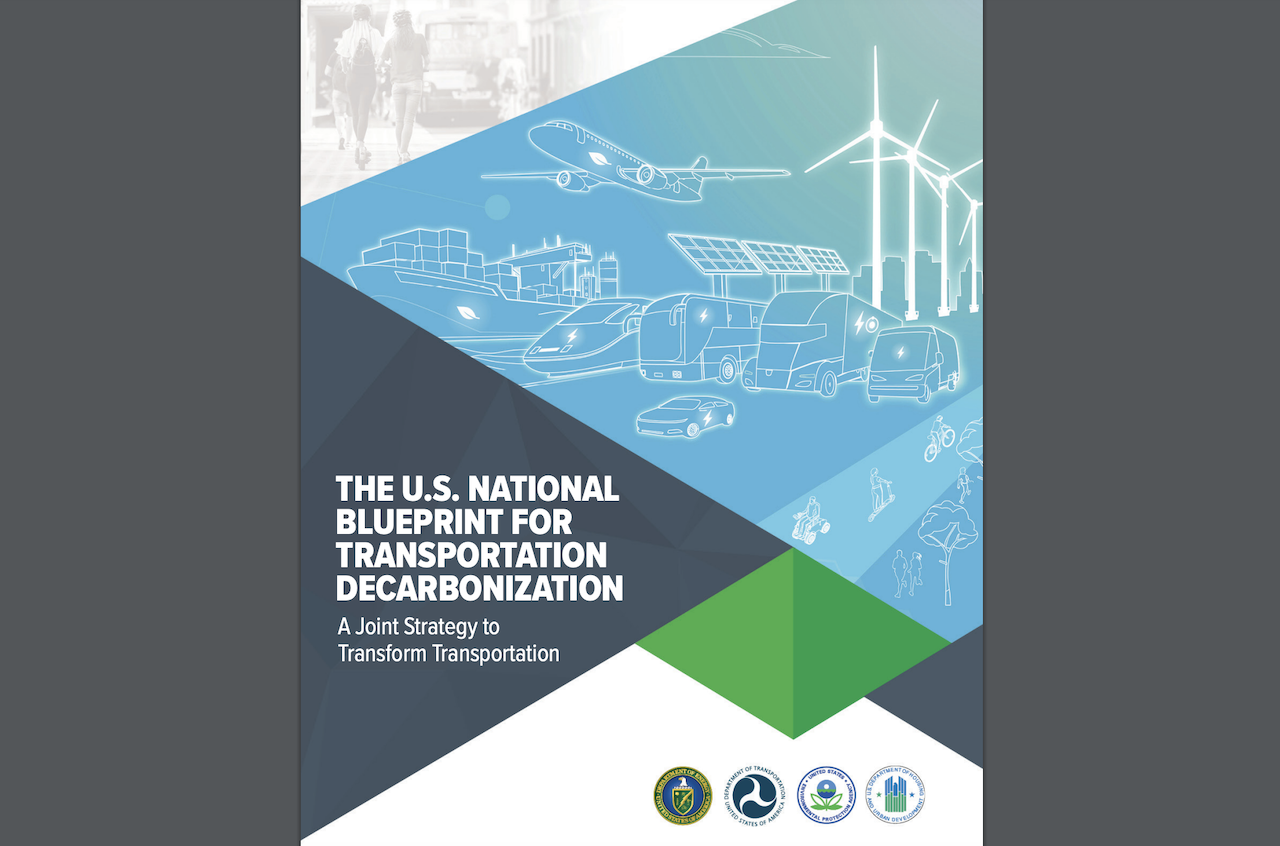
Biden Administration Releases U.S. National Blueprint for Transportation Decarbonization
Written by Carolina Worrell, Senior Editor
The Biden Administration has released the U.S. National Blueprint for Transportation Decarbonization, “a landmark interagency framework of strategies and actions to remove all emissions from the transportations sector by 2050,” the U.S. Department of Transportation (USDOT) announced Jan. 10.
Jointly developed by the Departments of Energy, Transportation, Housing and Urban Development (HUD), and the Environmental Protection Agency (EPA), the Blueprint “offers a whole-of-government approach to addressing the climate crisis and meeting President Biden’s goals of a 100% clean electrical grid by 2035 and net-zero carbon emissions by 2050.”
The Blueprint, follows a September 2022 Memorandum of Understanding (MOU) signed by the four federal agencies to “accelerate the nation’s affordable and equitable clean transportation future.” The MOU, the Office of Energy Efficiency & Renewable Energy said, called for the agencies to release a comprehensive strategy for decarbonizing the transportation sector that will help guide future policy decisions, as well as research, development, demonstration and deployment in the public and private sectors.
The Blueprint, USDOT says, will be followed by more detailed decarbonization action plans, to be developed and implemented by these agencies in cooperation with governments at the State, local, and Tribal level, philanthropic organizations, the private sector and global partners.
According to the Blueprint, the transportation sector, which includes all modes of travel through land, air, and sea to move people and goods, accounts for a third of all domestic greenhouse gas (GHG) emissions, negatively affecting the health and wellbeing of millions of Americans, particularly those in disadvantaged communities. Transportation costs are the second largest annual household expense in the U.S. and for the poorest Americans, the financial burden of transportation is “disproportionately and unsustainably high.”
A well-planned transition to a decarbonized transportation system can address these and other inequities and provide equitable, affordable and accessible options for moving people and goods, USDOT said. “Further developing and deploying clean-energy technologies, such as electric vehicles and hydrogen and sustainable fuels, while also building out the supporting infrastructure for clean transportation, will create good-paying jobs in all segments of the transportation sector while strengthening America’s energy independence.”
The Blueprint also presents the following three actions to decarbonize rail:
- Infrastructure investments in electric locomotives and the expansion of electrification corridors to help to accelerate the zero-emission transition. Interoperability and infrastructure for clean fuel technology adoption will facilitate efforts. Federal funding may be used to purchase more efficient and cleaner trains and to implement solutions that improve system-level efficiency. Other investments that will maximize emissions reductions include building strong domestic rail equipment supply chains for electric and alternatively fueled locomotives and railcars and supporting the development and deployment of sustainable fuels.
- Multi-stakeholder collaborations to accelerate the deployment of rail technologies that reduce emissions and increase efficiency. Ambitious and shared targets and regulation for the rail sector can help minimize investment risk and catalyze decarbonization actions. Existing industry partnerships such as EPA’s SmartWay Program are designed to improve efficiency and reduce emissions in the freight network. State freight advisory committees and rail and freight plans present opportunities for stakeholders to help identify pathways to transition fleets and modernize rail systems.
- Research and innovation to advance technology through pilot projects, greater infrastructure investments, and continued policy and regulation support that helps accelerate the growth of electrification of the U.S. passenger rail system. Freight rail research should be prioritized to determine the most promising paths to decarbonization, including a focus on sustainable fuels and the design and manufacture of new locomotive propulsion and fueling systems. The four agencies and partners should identify transformative pathways that can help inform the development of ambitious goals and regulation to reduce rail emissions. The continued collection of real-world operational data to better understand vehicle requirements and develop models and tools to perform technical analyses can help to identify the most viable pathways for clean technology solutions to replace diesel locomotives.
“It’s noteworthy that four federal agencies recognize freight rail’s ‘significantly higher efficiency that freight trucking,’” the American Short Line and Regional Railroad Association (ASLRRA) stated via a Twitter post.
The Blueprint, USDOT says, “is a critical step in the ongoing partnership between DOE, DOT, EPA, HUD and stakeholders and is a significant milestone on the path to realizing an improved and sustainable transportation future.”
“Transportation policy is inseparable from housing and energy policy, and transportation accounts for a major share of U.S. GHG emissions, so we must work together in an integrated way to confront the climate crisis,” said U.S. Secretary of Transportation Pete Buttigieg. “Every decision about transportation is also an opportunity to build a cleaner, healthier, more prosperous future. When our air is cleaner; when more people can get good-paying jobs; when everyone stays connected to the resources they need and the people they love, we are all better off.”
DOWNLOAD THE FULL U.S. NATIONAL BLUEPRINT FOR TRANSPORTATION DECARBONIZATION BELOW:



